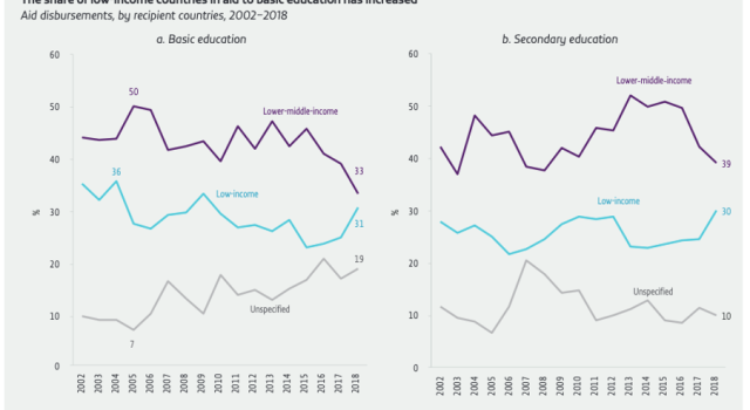Informe Gem Report
While the main message of our new policy paper on the latest figures of levels of aid to education is that COVID-19 is a serious threat to aid recovery, it would be a shame not to give greater attention to the positive story that we uncovered before the pandemic arrived. In 2018, total aid to education reached the highest amount ever recorded, US$15.6 billion. This is an increase of 9%, or US$1.25 billion, relative to the year before. Broken down by education levels, between 2017 and 2018, total aid increased by 6% in basic education, by 7% in secondary education and by 12% in post-secondary education.
Compared to 2010, when aid to education hit its previous high point shortly before the great financial crisis’s impact on ODA started to be felt, aid to education has grown by 16%, while aid to basic education has grown more slowly at 10%.
Even without a pandemic to contend with, however, there is still much room for improvement.
Education has long been losing ground as a donor priority. The share of education in aid that is clearly allocated to sectors (‘allocable aid’) fell from 14.8% in 2003 to 11.7% in 2010 and by another two percentage points to 9.7% by 2013. It has since recovered a little to 10.8%, but it is still below 2010 levels. The share of basic and secondary education in allocable aid is 6.3% (Figure 3a). If this share were 10% and all DAC plus selected non-DAC donor countries (Brazil, China, India, Kuwait, Qatar, the Russian Federation, Saudi Arabia, South Africa and the United Arab Emirates) dedicated 0.7% of their GNI to ODA, then the education financing gap would be filled.
The decline of education is particularly notable since other sectors have generally maintained their share of direct aid over time. Only a few sectors have gained ground, such as energy and the health, population and reproductive health sector (whose share increased from 15% in 2004 to 19.6% in 2013).
Donors prioritize different education levels
Aid to basic education reached US$6.5 billion in 2018, the largest amount ever recorded. Primary education accounts for about 90% of that sum; the rest consisted of small shares to early childhood education, life skills and school feeding programmes. Of that amount, low-income countries received 31%, or US$2 billion, a sharp increase from 2015, when they received 23% of the total, or US$1.3 billion. Lower-middle-income countries have seen their share decrease from 46% to 33% during this period, equivalent to a decline of US$0.3 billion.
A growing share of aid to basic education – 19%, or US$1.1 billion, in 2018 – is not tied to specific countries. The share of aid to secondary education that had unspecified recipients was only half the size of that of primary education. Even if it is assumed that all unspecified recipients of aid to basic and secondary education are low- and lower-middle-income countries, the total amount of aid to basic and secondary education was US$7.4 billion in 2018. The rest went to upper-middle- or even high-income countries and to post-secondary education. In other words, only 47% of aid to education goes to the two sub-sectors and the two groups of countries most in need.
Aid to secondary education, meanwhile, reached US$3 billion in 2018, again the largest amount ever recorded. Vocational training accounted for 56% of the total volume. Low-income countries received 30%, or US$0.89 billion, a marked increase from 2015, when they received 24%, or US$0.56 billion of the total. Lower-middle-income countries have seen their share decrease from 51% to 39% during this period, which means that aid has stagnated at US$1.2 billion.
In terms of regional allocations, the main development since 2010 has been the increasing share of Northern Africa and Western Asia as a result of the crises in the Syrian Arab Republic and Yemen. Between 2010 and 2018, the share of the region increased from 14% to 27% in aid to basic education and from 10% to 23% in aid to secondary education. The rise in 2018 reflects a significant increase of US$3.2 billion in budget support to Yemen, 20% of which is allocated to education, according to the GEM Report’s established methodology.
The share of sub-Saharan Africa in aid to basic education appears to have fallen by 10 percentage points in the last 10 years but this is probably accounted for by the commensurate increase in the share of aid to unspecified regions during this period. The analysis does not include humanitarian aid, which has continued to increase.
Aid to post-secondary education reached US$6.1 billion in 2018, also the largest sum on record. Excluding budget support allocated to post-secondary education, it consists of direct aid to post-secondary education (31%), scholarships for students in recipient countries to study abroad (21%), about one-third of which is not allocated to specific countries, and imputed costs for students studying in institutions of donor countries (48%). Upper-middle-income countries receive around 29%, or US$1.8 billion, a larger share than in basic or secondary education.
Across all levels, therefore, significant positive conclusions can be drawn about the general trend lines of aid to education from 2017 to 2018, even if improvements in the targeting of that aid are still urgently needed. It is a shame, therefore, to find in our analysis the extent to which COVID-19 is to rock the boat, with an expected 12% drop in international support for education from 2018 to 2022. Those advocating on this issue should take note of the policy recommendations in our recent aid paper, but should also remind donors of the positive advances recently made – a place which we can get back to with the right prioritisation and encouragement.
Fuente: https://gemreportunesco.wordpress.com/2020/07/28/how-much-aid-is-spent-on-education-and-where-does-it-go/







 Users Today : 52
Users Today : 52 Total Users : 35460069
Total Users : 35460069 Views Today : 69
Views Today : 69 Total views : 3418700
Total views : 3418700